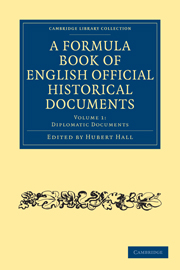Book contents
- Frontmatter
- PREFACE
- Contents
- ABBREVIATIONS USED IN THE REFERENCES, ETC. OF THIS WORK
- I INSTRUMENTS UNDER THE GREAT SEAL
- II INSTRUMENTS UNDER THE SMALLER SEALS
- III DEPARTMENTAL INSTRUMENTS
- IV SEMI-OFFICIAL INSTRUMENTS
- V STATE PAPERS AND DEPARTMENTAL INSTRUMENTS
- 1 ROYAL LETTERS AND OFFICIAL CORRESPONDENCE
- 2 ROYAL AND SECRETARIAL INSTRUMENTS
1 - ROYAL LETTERS AND OFFICIAL CORRESPONDENCE
Published online by Cambridge University Press: 05 October 2010
- Frontmatter
- PREFACE
- Contents
- ABBREVIATIONS USED IN THE REFERENCES, ETC. OF THIS WORK
- I INSTRUMENTS UNDER THE GREAT SEAL
- II INSTRUMENTS UNDER THE SMALLER SEALS
- III DEPARTMENTAL INSTRUMENTS
- IV SEMI-OFFICIAL INSTRUMENTS
- V STATE PAPERS AND DEPARTMENTAL INSTRUMENTS
- 1 ROYAL LETTERS AND OFFICIAL CORRESPONDENCE
- 2 ROYAL AND SECRETARIAL INSTRUMENTS
Summary
An epistolary style may be recognized in this country, as abroad, from a very early date, but at first the mediaeval letter must be regarded as a literary exercise rather than as a means of official communication. The dignified position of the feudal sovereign required the use of a more ceremonious style than that adopted by the polite letter-writer, and a convenient compromise was effected by means of the royal Writ. But although Writs of several kinds have been commonly included in printed collections of ‘Royal Letters,’ a distinction between the purely diplomatic and the epistolary styles may perhaps be suggested. Broadly speaking this distinction is seen in the transposition of the Superscription and Address, the omission of official Dispositive or Injunctive Clauses, and the substitution of a mere Valediction for a formal Attestation. It is true that the actual words of the diplomatic Superscription and Address are preserved in the modern letter, in which a conventional form of Notification and Exposition may frequently be recognized. Nevertheless, the distinction is at least of importance in respect of the transposition of the diplomatic formulas which was gradually effected between the 13th and 15th centuries.
In the earliest period, extending far into the 13th century, the only apparent distinction between the royal Letter and the royal Writ consists in a more familiar style of Address and Notification. An impersonal and vocative Address is rarely used, and then always in conjunction with the formulas of the diplomatic Superscription and Address, a Valediction being rare.
- Type
- Chapter
- Information
- A Formula Book of English Official Historical Documents , pp. 138 - 148Publisher: Cambridge University PressPrint publication year: 2010First published in: 1908



